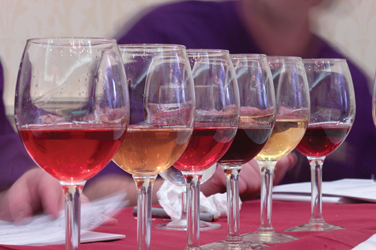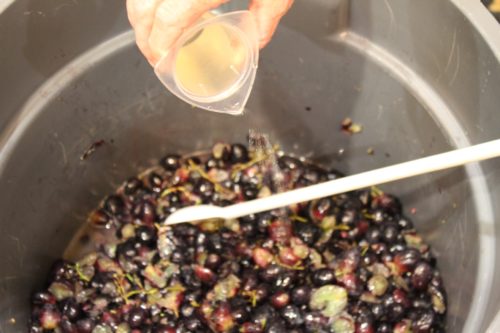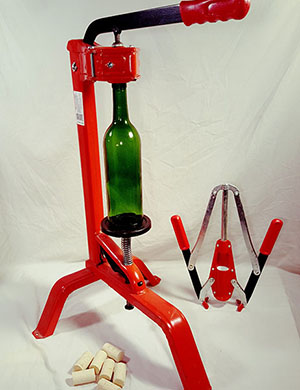 Country (non-grape) wines can be combined to create a blend that is better than the sum of its parts.
Country (non-grape) wines can be combined to create a blend that is better than the sum of its parts.
More and more savvy winemakers are discovering an unexpected similarity between grape and non-grape wines. The best wines are invariably blends. A great many varietal grape and non-grape wines lack depth, breadth and complexity. Blending not only produces an almost endless flow of integrated flavors, at its best it matches attributes that both complement and build upon one another.
We need to define our terms up front. When we say blend, we mean to combine two or more finished wines into one. We do not mean to combine ingredients and ferment them together, although that is a widely-practiced procedure.
As a prolific non-grape winemaker, I can attest that many blends are the product of necessity rather than planning. A particular wine might not turn out as hoped. It lacked something that another wine possessed. (And when those two were combined, they lacked something a third wine provided.) Blending trials allow winemakres to discover a blend that creates a wine far greater than the sum of its parts.
On other occasions, blends are planned from the outset. Specific wines are made and aged approximately half to two-thirds as long as they would be if they were to be bottled separately. Blending trials are conducted to determine the blending ratio.
But plans do not always work out. One wine may be so superior that it begs to be bottled as is, while another may lack a particular trait one anticipated. Therefore, it is always better to have a greater variety of wines available for blending than one expects will be needed. If one plans to blend crabapple, gooseberry and apricot, it would not hurt to have a fourth or even fifth wine on hand, perhaps some star fruit, peach or plum.
The fun in producing non-grape blends is in making the variety of wines necessary. Collecting the base ingredients and taking each through the necessary steps to produce a unique and irreducible wine is what winemaking is all about. Some such wines are ready to blend as soon as they have fallen brilliant, but others require aging to approach maturity.
It is neither required nor desired that the wines to be blended be, in fact, mature. Indeed, it is incumbent upon the winemaker to follow a wine’s progress and utilize it in a blend while it still retains potential for improvement. This is not an easy thing to judge, but fortunately for us, most wines are quite forgiving if we miss the mark by less than a mile.
Good Blending Foundations
There are wines which easily blend with many other wines, accommodating without overwhelming. They both hold the blends together and determine what styles the finished blends can or cannot be. These are the traditional foundation wines, but it is not required that any one of these wines be present in a blend. It just works out that one or more usually finds its way into the blend.
Apple wine has long been commercially flavored and fermented with fruit and berry extracts and concentrates, so we know it works well across a very wide spectrum. It is easily the first choice when blending malic wines (wines in which the acidity is dominated by malic acid). Crabapple makes a great, sometimes superior, substitute.
Banana wine can be a nemesis or a hero. It blends well with many, many other wines and contributes considerable body when otherwise lacking, but can be a problem to make until you master the technique. Do not use it for blending if it fails to fall brilliant.
Blackberry wine, made dark and with heavy body, is a favorite wherever blackberries grow. Thinner and lighter blackberry wines are not nearly as suitable for blending unless your goal is a light, delicate style. Blackberry is malic, but blends well with citric wines.
Blueberry wine is a fine blender for dark fruit, either citric or malic. Blueberry wine is perceived as heavy in the mouth, and for that reason it serves to anchor and tame more vibrant wines made with malic fruit or berries.
Citrus wines are wonderful foundations for fruit or berry wines dominated by citric acid. Orange and tangerine are the most neutral tasting, lemon and lime the most vibrant depending on your taste, but a well made grapefruit wine can also be notable.
Cranberry wine is an exceptional foundation wine. By itself, it can fool many into thinking it is White Zinfandel and it blends accordingly. It accommodates citric and malic wines equally well.
Plain mead (honey wine) is quite useful as a foundation, especially with flower, spice or herbal blendings. If finished sweet, it can also be quite useful in raising a bone dry wine to a semi dry or semi sweet while adding something that plain old simple syrup can never match. It also plays well with lighter fruit.
Pear wine is a reasonable and more subtle substitute for apple wine, but lacks the lively finish apple can deliver. But many fruits are quite capable of delivering their own finish, so do not be afraid to use it. I now use all of the pear wine I make in blends.
Rhubarb wine is an exceptional blender that readily yields to most other flavors while still adding discrete complexity. Rhubarb wine is malic, but blends across the spectrum.
The Secondary Blenders
Secondary blenders are the wines that will be blended with the primary wines, either singularly or in multiples. It would be impossible to list them all, obviously. But, if you need some suggestions, some of the more popular secondary blenders are almond, apricot, bilberry, Boysenberry, cherry, chokecherry, any of the currants, date, dewberry, elderberry, fig, gooseberry, huckleberry, kiwi, Loganberry, mango, Marionberry, mayhaw, nectarine, passionfruit, peach, persimmon, pineapple, plum, quince, any color raspberry, salmonberry, strawberry, or any combination of the foundation wines. Additionally, there is a huge variety of flower and herb wines quite suitable for blending.
A word about elderberry. A great many winemakers would consider it a primary blending wine. This author does not share that opinion because its flavor is so dominant that it almost always occupies a minor position in volume even though it contributes much to the taste. I have managed to spread a single gallon (~4 L) of elderberry wine into 18 different finished blends. A little goes a long way.
Pairings
There are certain wines that simply do not go well together — pineapple paired with blueberry is an example — while others pair off quite naturally. The idea is to couple the good pairings with a foundation wine that delivers the style you seek. Using two or more foundation wines is not unheard of. The chart on pages 32 and 34 is neither complete nor appropriate for all wines of the types listed. One must do blending trails, sample the wine and let your taste buds make the final decision.
Deriving the Blend
Let us suppose we have a gallon each of gooseberry and apricot and three gallons of a citrus wine made from Clementines and Valencia oranges. We first taste each wine critically and analytically, jotting down our impressions and rinsing the palate before tasting another. We find the gooseberry to be dry and flavorful, but slightly acidic and slightly hot from a little too much alcohol. The apricot is semi-sweet and flavorful but an odd wine, not flat but lacking in vibrancy. The citrus wine is semi-sweet, solidly citric and quite enjoyable.
Our notes tell us the gooseberry is acidic, high in alcohol and devoid of residual sugar. The apricot has some sugar but is low in acidity and possibly tannin. The citrus is solid as is. The apricot needs the gooseberry’s acid and the gooseberry needs the residual sugar in the apricot and citrus; the gooseberry can easily give its excess alcohol to the other two. The finished blend may or may not need some tannin. So where do we begin?
First, we need some way to accurately measure small amounts of liquid. I recommend visiting a scientific supply store and purchasing, at a minimum, a 50 mL graduated cylinder and a 10 mL pipette and/or a long tipped eye dropper. Better still would be a 25 mL, 50 mL and 100 mL cylinder but one can make do with the 50 mL for now. A 100 mL graduated beaker would be a good alternative, but if you are serious about your approach to blending trials, you might want to purchase 5 or 6 of these, too.
We first want to see how much of the gooseberry will satisfy the apricot’s acid deficiency. We should begin by measuring 15 mL of apricot and adding to it 5 mL of gooseberry, yielding a 25% gooseberry solution. Pour this into a wine glass, which will thoroughly mix the two wines together. Now measure 10 mL of apricot and add to it 10 mL of gooseberry, a 50% solution. Pour this into a second wine glass, Now combine 5mL of apricot with 15mL of gooseberry and pour this 75% solution into a third wine glass. First taste the 25% solution and note any improvement. Rinse and taste the 50% solution and evaluate it. Rinse again and taste the 75% solution.
If one is not quite right and the next is too acidic, you must prepare new solutions that will dissect the region between the two. This is where a pipette is valuable, allowing you to accurately add 1–9 mL portions to a prepared solution (a wine thief is a very large pipette). But for the sake of simplicity, let us say the 50% solution was perfect.
The gooseberry has satisfied some of its sugar deficiency from the apricot, but we now need to know how much citrus wine will be needed to dilute the gooseberry’s excess alcohol and satisfy any remaining need for sweetness. But we can no longer deal with the gooseberry as an isolated wine because we have already determined it needs to be in 50% solution with the apricot. So, we mix up 30 mL of apricot/gooseberry and draw 15 mL from that and add 5 mL of citrus to it, yielding a 25% citrus solution. We pour this into a wine glass and then mix 10 mL of apricot/gooseberry with 10 mL of citrus for a 50% solution. We dump this into another wine glass and take the final 5 mL of apricot/gooseberry and add 15 mL of citrus to it, for a 75% citrus solution. This goes into a third wine glass. Now we taste each to determine the best balance, juggling the sweetness with the high alcohol.
If one is almost right and the next too sweet, we know we can fine-tune the ratio with additional trials to get it right, but to simplify things, let’s say that the 75% citrus was perfect. Since the remaining 25% was half apricot and half gooseberry, the ratio is 1 part apricot, 1 part gooseberry and 3 parts citrus. If each part were a gallon, it would be perfect because that is exactly how much of each wine we had, minus the small amounts lost to trials.
It doesn’t usually work out quite so neatly, but providence does smile upon us all once in a while.
You may have to grab another wine you had not planned on using to bring some aspect into balance. You may not have enough foundation wine and have to press another variety into service. It is not unheard of to have to uncork several bottles of a recently laid down batch to fill a need at the blending bench.
Closing Thoughts
It should not need to be said (but will be anyway) that you do not blend a bad wine with a good expecting to improve the one with the other. Invariably, you ruin the good wine. Blending corrects deficiencies by averaging weaknesses with strengths through integration. When you throw a fault in there, you integrate the fault. Always start with sound wines.
Even with sound wines, every now and then things just do not work out as planned. It is possible to blend three perfectly clear — even brilliant — wines and have the blend slowly turn hazy on you. In almost every case, it is a matter of one or more of the wines have little or no pectic enzyme and a pectin haze develops.
Also, take care to sanitize the equipment used in blending. You would not want a bacterial bloom to ruin your beautiful blend.
There are scientific ways to construct blends, measuring TA, pH, SO2, residual sugar, pectin, tannin, alcohol, etc. Some find this way fun, but most do not. Aside from the huge investment in lab equipment and supplies, it is mathematically intensive and can completely remove the tongue from the process. Where is the fun in that? The reason we blend wines is to improve the tasting experience.
After you have blended a few wines and gained familiarity with the process and confidence in the outcome, you may very well be tempted to experiment where you think none have gone before. It is perfectly alright and, for a non-grape winemaker, expected of you. By all means have fun in what you are doing, but keep those yeast working.






